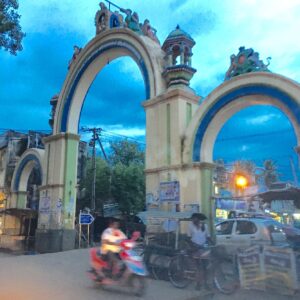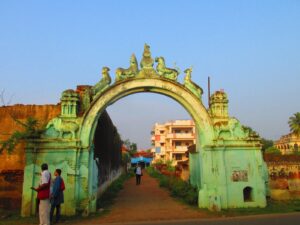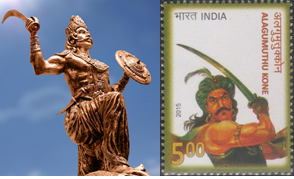
This day 79 years before, that is, on August 17, 1942 Devakottai, then Ramanathapuram district (now Sivagangai district) southern Tamilnadu witnessed a blood bath- blood shed by freedom fighters – death of 75 persons (including 14 women) and over 300 persons were injured (many grievously). Devakottai is situated on Tiruchirappalli-Rameswaram National Highway Road (NH-210). The town is 92 kms away from Madurai and 124 kms away from Rameswaram.
That deplorable incident reminded us the carnage that took place in Jalianwala bagh, Amritsar, Punjab on April 13, 1919.
As we all know, in 1942 nation-wide ‘ Quit India Movement ‘ was in full steam. Can Devakottai, a land which was the cradle of valiant queen like Velu Nachiyar and brave chieftains like Marudhu brothers, lag behind in freedom struggle? It is also apt to recall that the same Ramanathapuram district guided by great leader Muthuramalinga Thevar (Thevar Perumaganar) had sent hundreds of

men to join Indian National Army and fight against the imperialists.
Here, one more historical fact also has to be noted. Similar to Bengal famine, Ramanathapuram district has frequently faced droughts which were partly due to geographical factors and equally because of wrong policies or mismanagement of British Raj. In that manner, in late thirties the district was suffering due to successive years of famine. Further, the World War II also had accentuated their economic downfall and miseries. All these lead to disenchantment, helplessness and anger against the alien rulers.
Simmering discontentment burst out when the right trigger came in the form of Quit India Movement. As everywhere, many government officials quit the job to express their silent opposition to and non-cooperation with rulers. Those who were silent and mute spectators also gathered courage to join peaceful resistance movement. Freedom struggle, which was scaling up had reached its peak. All sections of the society, forgetting the barriers such as age- caste- linguistic – educated or uneducated- social status participated and took forward the movement. World War II had left the Britain’s economy in a severely battered situation. UK rulers started to realise that their grip on Bharat (the major raw material supplier and the large market for their products) was getting weakened day by day. Thus jolted rulers could not stomach even a democratic, lawful protests. Immediately, on giving the clarion call of ‘Quit India Movement ‘, at national level Mahatma Gandhi, Jawaharlal Nehru, Sardar Patel, Jayaprakash Narayan and at Madras Presidency level, Rajaji, Omandur Ramaswamy Reddiar, Kumaraswamy Raja, Sathiyamoorthu, Kamarajar and all were arrested. As the upsurge was swelling, The British government, issued 144 restraining orders across the country on August 14, 1942. However, the ban did not restrict soldiers seeking liberation.
In Devakottai and it’s neighbourhood like Tiruvaadanai, Sivagangai, Thiruvegamputhur also the protests started in a peaceful manner. Chittoor Sivagnanam and Balabharathy were notable persons took leading a poole in organizing – co-ordinating the protests. Sivagnanam was arrested, tied to a tree and shot down. Instead of quelling the uprising, this atrocious act of eliminating a simple person who had earned popular admiration, added fuel to the fire. Youth became restless. They met secretly and planned to keep up the momentum. Accordingly, people gathered and held demonstration in the centre of Devakottai town. Many were arrested in large numbers and moved to jail. D S Ramanathan and Chinna Annamalai were prominent persons imprisoned then and put in Thiruvadanai sub-jail.
Here, a word of introduction about Chinna Annamalai. This youngman was active in taking part in freedom movement right from the student days. In one meeting, Rajaji introduced him as ‘ Chinna ’ (young) Annamalai to distinguish from a senior person who was also of the same name. Chinna Annamalai, later became active lieutenant of Kamarajar. He was also a publisher of books espousing nationalist causes.
Fearing the recently arrested youngsters also could face the same fate of Sivagnanam, that is being killed in fake encounters, freedom warriors gathered overnight in the village of Thiruvegambathur. The plans were drawn up under the leadership of freedom fighter Balabharati.
They set out to end the British oppression in Devakottai, Thiruvegambathur and Thiruvananthapuram. At midnight on August 15, 1942, the bridges between the two towns of Thiruvegambathur and Thiruvadanai were demolished. The traffic was cut off. On the morning of the 17th, Abiramam Muthiah and Jayaram Iyer of Thiruvegambathur took a bicycle and cut off telecommunications. Chellathurai coordinated the march.
Freedom fighters demolished the Thiruvadanai jail. More than 30 freedom fighters, including Chinna Annamalai and DS Ramanathan, were released. The prison treasury was looted. The taluka office and the office of the deputy registrar of the police station were looted. Further, a faction of freedom fighters started moving towards Devakottai.
With much difficulty, army was called in. Military officials warned that freedom fighters would be fired upon if they entered the Devakottai border. The crowd had become emboldened and were ready for anything and were advancing towards Devakottai as true fearless hearts. Near the present Devakottai municipality, the military was waiting with loaded guns for the freedom fighters to arrive.
Determined freedom fighters did not fear even when they came face to face with the guns. British Army shot down Muthirulappan to put a stop to the advanced freedom fighters. As a result, angry freedom fighters stormed the Devakottai court, looted and set fire to documents. The Simpson Company buses run by white rulers were set on fire.
The British army officers were outraged to see the freedom fighters fighting furiously before their eyes. Thus, a series of shootings were carried out on the freedom fighters. The British army shot and killed 75 people, as if to shoot down a flock of birds. Hundreds were injured.
The martyrs’ list included Dharmarajan Iyer, Manivannan, Nadesan, Krishnan, Chavalkattu Maniyan and Sivanandi Chettiar’s mother, who ran the Rajan Institute.
After our independence, a memorial pillar and later a park (Martyrs’ Park stand there as silent witness to the sacrifice made by those noble men and women.

